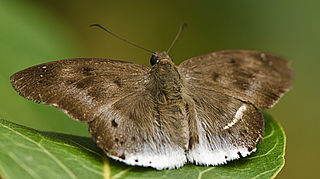
Tagiades japetus, commonly known as the pied flat or the common snow flat, is a species of spread-winged skipper butterfly belonging to the family Hesperiidae. It is widely distributed, being found from India, the Himalayas, Southeast Asia, to Australia. It contains several recognized subspecies.
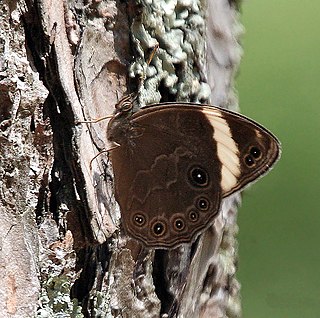
Lethe is a genus of butterflies in the subfamily Satyrinae of the family Nymphalidae. The genus was erected by Jacob Hübner in 1819. It includes the treebrowns, woodbrowns, foresters and their relatives. The species in the genus Lethe occur in temperate-tropical southern and eastern Asia, up to Indonesia and in North America.

Marumba dyras, the dull swirled hawkmoth, is a species of hawk moth described by Francis Walker in 1856. It is found in South-east and South Asia.

Dophla evelina, the red-spot duke, is a species of brush-footed butterfly found in Cambodia and South and Southeast Asia. Many subspecies are accepted. The species was first described by Caspar Stoll in 1790.
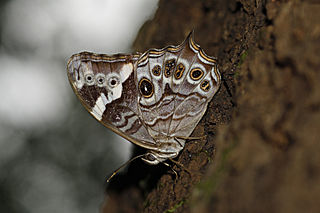
Lethe rohria, the common treebrown, is a species of satyrine butterfly found in Asia.
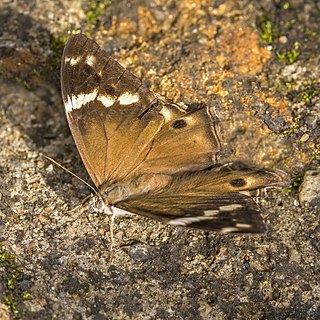
Lethe drypetis, the Tamil tree brown, is a species of Satyrinae butterfly found in South India and Sri Lanka.

Ionolyce helicon, the pointed lineblue, or bronze lineblue, is a small butterfly found in the Indomalayan realm that belongs to the lycaenids or blues family.

The Ceylon tree nymph is a species of nymphalid butterfly in the subfamily Danainae. It is endemic to Sri Lanka. First described by John Westwood in 1848, the Ceylon tree nymph can be found in both wet and dry zones of Sri Lanka. It is the largest member of the family Danaidae in that country. It is listed as a near threatened species in the IUCN Red List.

Cephonodes hylas, the coffee bee hawkmoth, pellucid hawk moth or coffee clearwing, is a moth of the family Sphingidae. The species was first described by Carl Linnaeus in 1771. A widely distributed moth, it is found in the Near East, Middle East, Africa, India, Sri Lanka, Japan, Southeast Asia and Australia.

Hippotion velox, the dark striated hawkmoth, is a species of sphingid moth or the family Sphingidae. The species was described by Johan Christian Fabricius in 1793.

Thyas coronata is a species of moth of the family Erebidae first described by Johan Christian Fabricius in 1775. It is found from the Indo-Australian tropics of southern China, Taiwan, Japan, Nepal, India, Sri Lanka to Micronesia and the Society Islands.

Pergesa is a monotypic moth genus in the family Sphingidae first described by Francis Walker in 1856. Its only species, Pergesa acteus, the green pergesa hawkmoth, was described by Pieter Cramer in 1779.

Oraesia emarginata is a species of moth of the family Erebidae first described by Johan Christian Fabricius in 1794. It is found in Australia, New Caledonia, Indonesia, New Guinea, Pakistan, the Philippines, India, Sri Lanka, Sulawesi, Taiwan, China, Japan, Korea and Nepal as well as Eritrea, Ethiopia, Kenya, Namibia, Nigeria, South Africa, Tanzania, the Gambia, Uganda, Oman and Yemen.

Indothemis carnatica, the black marsh skimmer, or light-tipped demon, is a species of dragonfly in the family Libellulidae. It is found in India, Sri Lanka and Thailand.
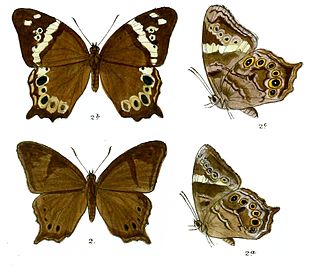
Lethe daretis, the Sri Lanka treebrown, is a butterfly in the family Nymphalidae. It is endemic and restricted to cloud forests of central highlands of Sri Lanka such as Horton Plains.

Mycalesis rama, the Cingalese bushbrown, is a species of satyrine butterfly of family Nymphalidae. It is a very shy animal, distributed in bamboo forests. It is endemic to Sri Lanka.
Nacaduba ollyetti, the Woodhouse's four-line blue, is a species of Lycaenidae butterfly. It is endemic to Sri Lanka.

Nacaduba sinhala, the Pale Ceylon line blue, or Ceylon six-lineblue, is a species of Lycaenidae butterfly. It is endemic to Western Ghats complex.

Udara singalensis, the Singalese hedge blue, is a species of Lycaenidae butterfly. It is endemic to Sri Lanka.
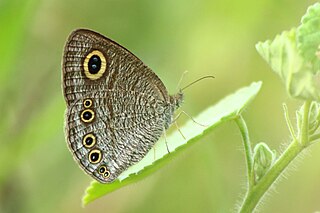
Ypthima singala, the jewel four-ring or Sinhalese five-ring, is a species of Satyrinae butterfly. It is endemic to Sri Lanka and south India.


















